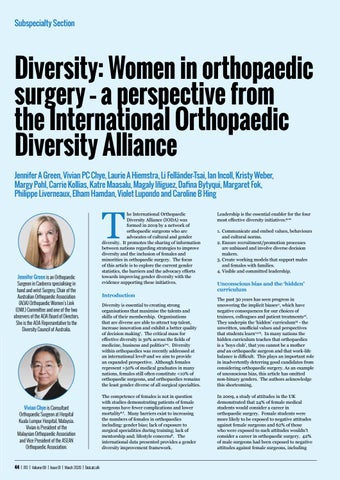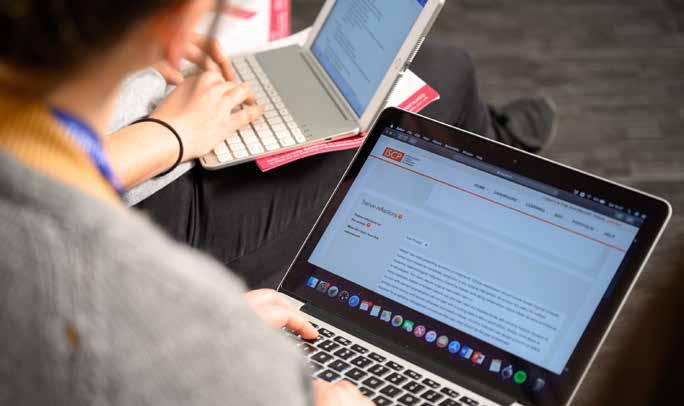Subspecialty Section
Diversity: Women in orthopaedic surgery – a perspective from the International Orthopaedic Diversity Alliance Jennifer A Green, Vivian PC Chye, Laurie A Hiemstra, Li Felländer-Tsai, Ian Incoll, Kristy Weber, Margy Pohl, Carrie Kollias, Katre Maasalu, Magaly Iñiguez, Dafina Bytyqui, Margaret Fok, Philippe Liverneaux, Elham Hamdan, Violet Lupondo and Caroline B Hing
T
Jennifer Green is an Orthopaedic Surgeon in Canberra specialising in hand and wrist Surgery, Chair of the Australian Orthopaedic Association (AOA) Orthopaedic Women’s Link (OWL) Committee and one of the two observers of the AOA Board of Directors. She is the AOA Representative to the Diversity Council of Australia.
Vivian Chye is Consultant Orthopaedic Surgeon at Hospital Kuala Lumpur Hospital, Malaysia. Vivian is President of the Malaysian Orthopaedic Association and Vice President of the ASEAN Orthopaedic Association.
44 | JTO | Volume 08 | Issue 01 | March 2020 | boa.ac.uk
he International Orthopaedic Diversity Alliance (IODA) was formed in 2019 by a network of orthopaedic surgeons who are advocates of cultural and gender diversity. It promotes the sharing of information between nations regarding strategies to improve diversity and the inclusion of females and minorities in orthopaedic surgery. The focus of this article is to explore the current gender statistics, the barriers and the advocacy efforts towards improving gender diversity with the evidence supporting these initiatives.
Introduction
Leadership is the essential enabler for the four most effective diversity initiatives:9,10 1. Communicate and embed values, behaviours and cultural norms. 2. Ensure recruitment/promotion processes are unbiased and involve diverse decision makers. 3. Create working models that support males and females with families. 4. Visible and committed leadership.
Unconscious bias and the ‘hidden’ curriculum
Diversity is essential to creating strong organisations that maximise the talents and skills of their membership. Organisations that are diverse are able to attract top talent, increase innovation and exhibit a better quality of decision making1. The critical mass for effective diversity is 30% across the fields of medicine, business and politics2-4. Diversity within orthopaedics was recently addressed at an international level5 and we aim to provide an expanded perspective. Although females represent >50% of medical graduates in many nations, females still often constitute <10% of orthopaedic surgeons, and orthopaedics remains the least gender diverse of all surgical specialties.
The past 30 years has seen progress in uncovering the implicit biases11, which have negative consequences for our choices of trainees, colleagues and patient treatments12. They underpin the ‘hidden’ curriculum13 - the unwritten, unofficial values and perspectives that students learn14,15. In many nations the hidden curriculum teaches that orthopaedics is a ‘boys club’, that you cannot be a mother and an orthopaedic surgeon and that work-life balance is difficult. This plays an important role in inadvertently deterring good candidates from considering orthopaedic surgery. As an example of unconscious bias, this article has omitted non-binary genders. The authors acknowledge this shortcoming.
The competence of females is not in question with studies demonstrating patients of female surgeons have fewer complications and lower mortality6,7. Many barriers exist to increasing the numbers of females in orthopaedics including: gender bias; lack of exposure to surgical specialities during training; lack of mentorship and; lifestyle concerns8. The international data presented provides a gender diversity improvement framework.
In 2009, a study of attitudes in the UK demonstrated that 24% of female medical students would consider a career in orthopaedic surgery. Female students were more likely to be exposed to negative attitudes against female surgeons and 62% of those who were exposed to such attitudes wouldn’t consider a career in orthopaedic surgery. 42% of male surgeons had been exposed to negative attitudes against female surgeons, including












